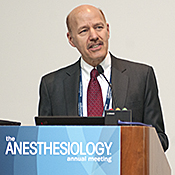One of the great debates in health care was addressed Sunday when two physicians discussed the relationship between physicians and industry during “Commercialism: Conflict of Interest or Critical Ally?”

Ronald G. Pearl, M.D., Ph.D.
Ronald G. Pearl, M.D., Ph.D., argued against such relationships in “Alliances With Pharmaceutical and Equipment Manufacturers Prejudice Students, Faculty and Clinicians and Create Commercial Bias in Patient Care, Research and Education.” Taking the opposite position was Steven J. Barker, M.D., Ph.D., who presented “Alliances With Pharmaceutical and Equipment Manufacturers Promote Innovation, Research, Education and Patient Safety.”
“Why discuss this now? Because the stakes are larger than ever,” said Dr. Pearl, Professor of Anesthesiology, Perioperative and Pain Medicine at Stanford University School of Medicine. “Profits have escalated to (levels) that are unprecedented and the costs have escalated, making it very difficult to do research, especially in a time of declining NIH funding.”

Steven J. Barker, M.D., Ph.D.
Industry spends $5 billion annually to fund research, and in 2013, 25,444 patents were filed. More than half of all research is tied to industry, he said. The problem is that industry and academics have different goals. The goals in academics are to improve health and reduce disease through research, clinical care and education. On the industry side, the goal is to generate profits for shareholders.
Dr. Pearl used tobacco industry ads from the 1940s and 1950s showing doctors endorsing brands of cigarettes to demonstrate the dangers of blurring the lines between industry and academics.
“Can we trust ourselves to behave appropriately and resist pressure from industry to do what they want us to do?” he asked. “No. We have to understand what goes on in our minds.”
Today, the cost of the hepatitis C treatment Harvoni® is $1,125 per pill, with a total cost of $189,000 for a course of treatment, Dr. Pearl said.
To demonstrate how academics are influenced by industry funding, Dr. Pearl said that an Institute of Medicine report inidcated that 21 percent of department chairs are members of commercial speaker bureaus.
“The profit motive of industry is often incompatible with the goals of academic research and education,” he said.
Dr. Barker, a longtime academic and now Chief Science Officer for Masimo Corporation, did not disagree with some of Dr. Pearl’s points, adding, “This is a debate we must have. We have to make this marriage work. This is how we make health care better.”
While Dr. Pearl said disclosures of industry involvement did not deter potential conflicts of interest for physicians, Dr. Barker said open acknowledgement of potential conflicts can be viewed as a positive action.
“We have to treat physicians like adults and not wayward children,” he said. “Limiting access to industry reps can have the unintended effect of reducing appropriate responses to negative information about drugs just as much as responses to positive information about innovative drugs.”
Dr. Barker also said that medicine is treated differently than other professions in regard to relationships with industry, asking “Are all corporate relationships driven by greed?”
Over the years, close relationships between academics and industry have led to medical advances such as the development of insulin and pulse oximetry, he said.
“This marriage is very productive,” Dr. Barker said. “Can we do better at controlling bias and conflicts of interest? We can, but at what cost? If we overregulate, we can destroy our partnership. We need to find the balance between oversight and creative productivity.”
